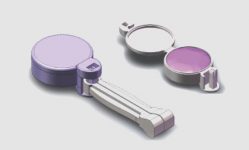
Tennessee Hospital adopts RFID TotGuard system to protect newborn babies
[ad_1]
When the Central Tennessee Medical Center opens a new hospital next year, it will use GuardRFID Solutions’ TotGuard system, using 344 MHz active RFID tags and readers to ensure the safety of neonates and pediatric patients.
The new hospital has an investment of US$267 million and has a total of 286 beds. It is scheduled to open in 2010 and can accommodate the hospital’s current annual birth rate of 2,500 babies. The management hopes that the new hospital will install a security system that can improve the safety of the existing hand-checked bar and text wristbands worn by infants, said Janet McIntosh, director of maternal and child services at the center.
“We hope that the new hospital will be the most advanced in all aspects,” McIntosh said, including baby safety. “We will not use an infant safety system to completely replace manual inspections; nurses still need to be alert to the surrounding environment and check the wristbands,” she explained. Because of this understanding, hospitals tend to choose systems that are easy for employees to operate. If a baby approaches the exit or someone tries to remove the baby seat belt, the system will send an alert to add a layer of safety.”
The center and GuardRFID jointly discussed the use of the TotGuard system, and visited other hospitals that adopted the system, and finally decided to adopt this system. When the baby is born, the staff sticks a TotGuard RFID tag on a soft fiber tape, and wraps it on the baby’s forearm or foot through a Velcro holder. Information such as the baby’s health record, date and time of birth, and parents’ names are entered into the TotGuard system installed on the central server. The employee then uses an RFID reader to read the ID code assigned to the baby, and corresponds the ID code to the data stored in the TotGuard software.

Umbilical cord label
The tag will send a unique ID code at a rate of once every 10 seconds, with two embedded sensors, one to detect changes in light and the other to detect changes in temperature. If parents temporarily remove the baby tag, GuardRFID president Zahir Abji said that the light sensor will detect that the tag is picked up from the baby’s skin. However, due to such short-lived and unintentional tag movement too frequently, the system uses a temperature sensor for further detection. If the label is completely removed, the temperature sensor detects the drop in temperature, and the light sensor also detects the change of light, thereby issuing an alarm.
“This reduces useless alarms,” Abji said. The alert will be displayed on the employee’s computer in the form of a pop-up window. After responding to the alarm, the employee must log in to the software and enter the reason for the alarm.
The hospital may also use a TotGuard label enclosed in a disposable plastic box, which can be directly attached to a small clamp on the stubble of the baby’s umbilical cord. Compared with the standard TotGuard label, this label is more difficult to remove, and it is more waterproof, and it is not necessary to remove the label when the baby is bathing. If someone attempts to remove the label, he must open or cut off the clip, and the label light sensor will detect the light and trigger an alarm.
60 GuardRFID readers connected to the server via Ethernet cables are installed in various places in the hospital, covering the entire obstetric department, entrances and exits, elevators and stairs in other areas of the building in real time. In addition, GuardRFID will install a total of 18 activators at the entrance and exit of the hospital. The activator sends a 125 kHz signal that can be detected by the TotGuard tag. If the tag enters the signal range of any activator, it will immediately send the signal more frequently, prompting the TotGuard software to pop up an alert window on the hospital computer screen.
At any time, the label is read by at least three readers or near the exit during the production. In this way, this system accurately locates the baby’s position within 10 -12 feet by combining triangulation and tag signal strength.
The system can also be integrated with an IP camera to provide users with a video image of an event happening at an entrance and exit, for example, when an alarm is triggered. This system is designed to be more flexible. According to GuardRFID sales director Beth Bandi, the middleware can integrate RFID read data and other information, such as asset management or other hospital functions, such as admission or discharge. This software is very intuitive to use, even employees who are not familiar with this system can quickly master it.
[ad_2]



